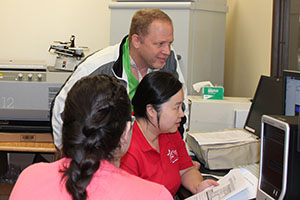Three students
from Lone Star College-CyFair traveled to

Using LSC-Montgomery’s High Performance Liquid Chromatography Mass
Spectrometry (HPLC-MS) is LSC-CyFair’s first step in completing this design
project for NASA. (From left to right: Kevin Dolan, Jesse Goerlich, Tania Ascosta (back
of head), Professor Danny Kainer and Professor Yiheng Wang.
Lone Star College-Montgomery to use special
equipment to conduct research for NASA.
The Texas Space Grant Consortium
(TSGC) selected the LSC-CyFair students to participate in the Spring 2016 Design
Challenge. Their project tests the leak rate of lithium batteries.
“This research puts a little bit
of pressure on us,” says student Kevin Dolan. “I did not expect to do any of
this at community college.”
Student Tania Ascosta agrees. She
says, “We are experiencing work on this project that we would normally be
experiencing after graduation.”
The LSC-CyFair team was planning
on using NASA’s equipment for the experiment, but the equipment stopped working
and the team needed to find their own instruments to complete the research. LSC-CyFair
Professor Dr. Yiheng Wang, the faculty advisor on the project, asked Dean
Claire Phillips for help. “I totally meant it as a joke,” Wang says. “I wrote
her an email: ‘With little to no hope I am checking with you, do we have Gas Chromatography
Mass Spectrometry (GC-MS) equipment in our chemistry lab?’ Dean Phillips wrote
back, ‘We don’t, but I think Dr. Danny Kainer at LSC-Montgomery does.’”
Turns out Kainer had a different
instrument, a High Performance Liquid Chromatography Mass Spectrometry
(HPLC-MS). The LSC-CyFair team could use the HPLC-MS, but they had to modify
their research method.
Wang is an engineering professor
at LSC-CyFair, while Kainer is a biotechnology professor at LSC-Montgomery. Kainer
says, “We usually apply this instrumentation to biotech-type applications, but
just because we do that doesn’t mean the machine can’t be used in other kinds
of industries too. In this case, this is more of a material-science-type
project, but the same type of instrumentation can be used.”
Using LSC-Montgomery’s HPLC-MS is
LSC-CyFair’s first step in completing this design project for NASA. “This is
just a tool,” says Wang. “It is going to give us data, then we have to move
onto original research. The difficult part comes next. “
For more information on the engineering program at LSC-CyFair contact Dr.
Yiheng Wang at Yiheng.Wang@lonestar.edu
For more information on the biotechnology program at LSC-Montgomery
contact Dr. Danny Kainer at Daniel.B.Kainer@lonestar.edu
For more information on the Texas Space Grant Consortium (TSGC) Spring
2016 Design Challenge visit tsgc.utexas.edu/challenge/teaminfo2.html
LSC-Montgomery is located at 3200 College Park Drive, one-half mile west
of Interstate 45, between Conroe and The Woodlands. For more information about
the college, call 936.273.7000, or visit www.LoneStar.edu/montgomery.
Lone Star College System has been opening doors to a better community
for more than 40 years. Founded in 1973, LSCS remains steadfast in its
commitment to student success and credential completion. Today, with
almost 83,000 students in credit classes, and a total enrollment of more than
95,000, Lone Star College System is the largest institution of higher education
in the Houston area and one of the fastest-growing community college systems in
the nation. Stephen C. Head, Ph.D., is the chancellor of LSC, which
consists of six colleges including LSC-CyFair, LSC-Kingwood, LSC-Montgomery,
LSC-North Harris, LSC-Tomball, and LSC-University Park, seven centers,
LSC-University Center at Montgomery, LSC-University Center at University Park,
Lone Star Corporate College, and LSC-Online. To learn more visit LoneStar.edu.
